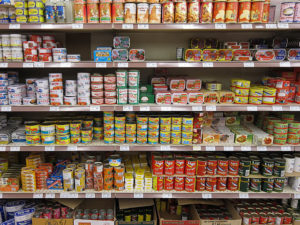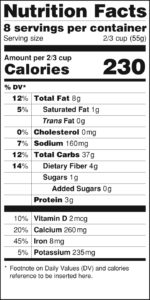 It normally happen at the supermarket when you have to choose one product out of a full shelf and you can’t take a final decision.
It normally happen at the supermarket when you have to choose one product out of a full shelf and you can’t take a final decision.
You stand there looking at the back label, frowning your eyebrows while reading the ingredients and nodding your head pretending you know what they are.
Sure you know the most common ingredients but you get lost when those chemical names show up. Let’s say that if most of the ingredients are understandable and you like them, you may buy that thing.
So, let’s learn how to read the labels!
It’s ok to read the ingredients but most importantly you want to check the nutrition facts table. The nutrition facts table is now in every product in most countries and indicates the amount of different macro nutrients.
But, what the heck are these macro nutrients?
In 3 words:
- Proteins
- Carbohydrates
- Fat
These 3 components are the primary source of “materials” that your body need. Everything you eat is composed by at list one macro nutrient (except of course water, minerals and vitamins).
Proteins are the building blocks for your muscles and body. If you are working out, you want to have plenty of proteins to build up your muscles. That’s why body builders always use protein shakes. However, proteins turn to fat by the liver if you consume too much of it (or you are not working out) and if your body doesn’t use them.
1 Gram of protein equals to 4 calories.
Carbohydrates (or Carbs) are the energy source for your activity. Take Carbohydrates before intense activity like running or gym sessions.
If Carbohydrates are not “burned” during the activity following your meal, it will be stored as fat.
1 gram of Carbs equal to 4 calories.
Fat is just fat (sometimes labeled as “lipids”) and will remain fat in your body. It will eventually be used for fuel when you engage in an intense exercise routine. A minimum fat intake is necessary to keep your body and organs functioning. Normally you don’t really want too many calories from fat.
1 gram of fat equals to 9 calories.

Let’s see the nutrition table in the label in Figure 1.
We can read that 2/3cup (55 grams) contain a total of 230 calories.
If we calculate the amount of each macro nutrient following the table, the result will be as follow:
Fat: 8g ( x 9 cal.) = 72 calories
Carbs: 37g ( x 4 cal.) = 148 calories
Protein: 3g ( x 4 cal.) = 12 calories
You can see the matching result (72 + 148 + 12 = 232 calories every 55 grams of this product. Calories count is always rounded for practical use)
As previously mentioned, a high quantity of carbohydrates like this (148 calories) could be ideal prior running or endurance training to ensure a good level of fuel to burn.
At this point you may be confused about how many calories you should get from each of the macro nutrients!
An ideal intake ratio of the 3 macro nutrients can be achieved by using the “1-2-3 rule of thumb”.
1 Part of Fat – 2 Parts of Protein – 3 Parts of Carbohydrates.
For example, if you need a total of 600 calories:
100 calories from Fat
200 calories from Protein
300 calories from Carbohydrates
A quick tool you can use to find how many daily calories you need can be found at this link. Anyway I highly suggest you to consult a personal trainer or a dietitian to have a precise valuation.
When possible, try to organize your calories intake by separating your daily total needs into 5 meals. Eat more when you plan to do more and take a snack when you plan to be less active.
These 3 macro nutrients are the most important thing you should acknowledge for your own diet. It’s not difficult to understand that canned food is not the best source of nutrients. Try to buy your groceries at the fresh market as much as you can and get a book with complete nutrition charts and more detailed info about the food you are eating.
In case you want to get a more “fusion” diet, check out the chart here below to learn about the nutrients you can have by eating bugs!
Now I have a question for you:
How many calories from protein, carbohydrates and fat are in 150 grams of Dung Beetle?

Photo Credits:
“99 Ranch Market San Jose June 2011 001” by King of Hearts – Own work. Licensed under CC BY-SA 3.0 via Wikimedia Commons.
“Bugs in the System” nutrition chart from the book by Mary Berenbaum.



One thought on “How Understanding Nutrition Facts Labels can Improve Your Meals”